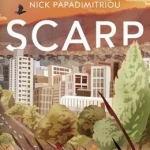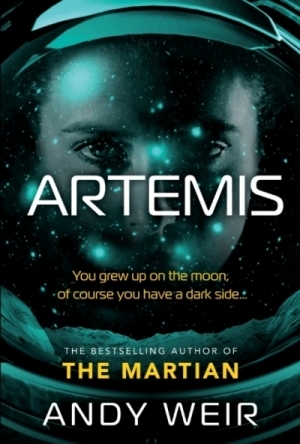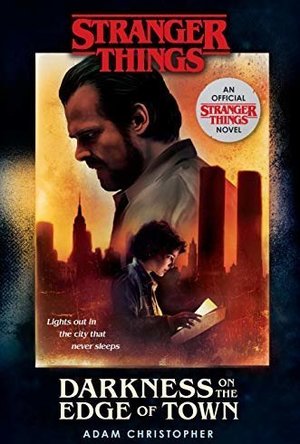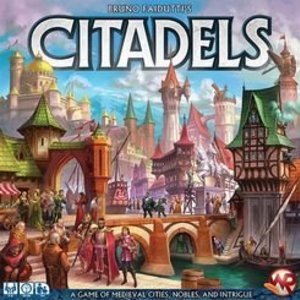
The Simpsons™: Tapped Out
Games and Entertainment
App
THIS GAME IS LIFE-RUININGLY FUN! From the writers of The Simpsons, comes the city building game that...
Joe Julians (221 KP) rated Artemis in Books
Feb 17, 2018
Artemis isn't a bad book and there's plenty of things to enjoy here. The moon based setting complete with it's changes in gravity and Kenyan set up make for an interesting read. There's a ton I want to know about Artemis and Weir does a great job in bringing this place to life. But it feels like there could have been more explored here and it's like the surface is only just being scratched.
With his central character, Jazz, we basically have another version of the lead from The Martian. The same wise cracks are there, but whereas with Mark Watney the wise cracking feels natural- here it feels forced. It doesn't help that Weir decided to write this from the perspective of Jazz, a Muslim woman. Some of the worst aspects of the book are based on that decision. Some of the dialogue here is appalling- embarrassing even. There were many moments I just groaned at how childish some of the things he makes Jazz say are. This doesn't feel like a woman talking. Instead it feels like what it is- a man trying to write as a woman but failing. Which is a shame as Jazz is an interesting character and one I could at times enjoy spending time with- other times though I couldn't stand her. Characters are a problem across the whole story really. Side characters feel under developed and there wasn't really anyone that I could single out as a highlight- none of them felt natural.
There's issues with the story itself too. This is essentially a heist story, but the heist is actually the least interesting part of Artemis. Rarely did I find myself invested in what was going on and this actually got worse as things went on. The first half of Artemis did a good job at setting things up, it's just a shame that as the story started building towards a climax- it lost momentum at the exact moment it should be gaining it.
Also, the science talk. Weir loves science, that's obvious. But here it at times feels like he is showing off to prove how much he knows. I don't actually think he was, but I quickly started to faze out when he went into details about how something works as it came so hot on the heels of a previous explanation of something else. I'm also so bored of welding now that I don't want to ever hear the word again.
I feel like I'm being a tad harsh here by focusing on the negatives. I do want to stress this book isn't bad. I may have got bored and frustrated on occasion I did however for the most part enjoy it. As I said Artemis is a great place and the city is one that I would love to have him explore in future installments. And while Jazz and a lot of the things she said did irritate me, there were flashes of brilliance with the character. I think personally I would like a second book to focus on someone new, but if Weir could sort the dialogue and some of her more annoying traits out- I'd happily spend more time with her.

Construction Simulator 2
Games
App
Ranked #1 for the iPad & iPhone in 25 Countries In the Top Ten for the iPad & iPhone in 66 Countries...

Moose Math - by Duck Duck Moose
Education and Games
App
Moose Math engages kids in a mathematical adventure and teaches counting, addition, subtraction,...
Hadley (567 KP) rated Stranger Things: Darkness on the Edge of Town in Books
Jul 17, 2019
Adam Christopher is the chosen author to tell Stranger Things' fans about the most important homicide case that Jim Hopper ever worked on in the novel 'Darkness on the Edge of Town.' Fans may recall from season 2, when Eleven found a secret hatch in Hopper's cabin, it revealed boxes under the floor - one which was labeled 'New York.' This is that story.
The entire book is Hopper telling Eleven about his greatest homicide story from New York City. Readers get to meet new characters from Hopper's past, but the most memorable may be his partner in the Homicide Unit, Rosario Delgado (1977 was a time where Homicide Units didn't allow female detectives, and Delgado is one of the first of few that is allowed into the unit). Delgado, who is Cuban, but was raised in Queens, New York, has all the right attitude that wins over her partner, Hopper. The reader will realize that they are two-peas-in-a-pod.
Quickly, the story gets into the first case the two have together: the Zener card serial killer; here, we learn that there were two previous victims, both murdered the same way: stabbed five times with the wounds joining together to form a five-pointed star. Throughout the book, the story goes back and forth between 1977 and the present, where Eleven asks questions about the story, and also, Hopper questioning himself as to whether he should continue to tell Eleven the story.
But soon, we meet a very important man named Leroy Washington - a gang member who wants protection in exchange for the information that he holds- this leads Hopper to our villain: a cult leader who goes by the name Saint John. This villain believes that Satan is going to rise and destroy New York City.
Backtracking a little before, Hopper and Delgado are taken off the case of the Zener card murders, introducing readers to Special Agent Gallup. Gallup states that the third victim, Jacob Hoeler, was also a Special Agent, so the case is turned over to Federal Agents. "What you don't know, Detective, is that Jacob Hoeler is one of ours- - - Special Agent Jacob Hoeler. He was working on assignment, and the fact that he was killed in the course of his duties is of primary concern to my department. Therefore, we need to be sure that a most thorough investigation is carried out. In order to ensure that happens, we will be taking the case in-house. " Hopper, along with Delgado, refuse to let the case go, and secretly continue to work on it. But, as they dig deeper into the evidence and crime scenes, the two realize the murder case is a part of something much bigger - - - a cult that is armed with vehicles and weapons, ready to take over New York City for their leader, Saint John.
Readers get to see the story from both Hopper's and Delgado's point of view, which readers may question how Hopper knows Delgado's side of the story, but quickly to react, Eleven asks this very question for us: " 'Fair point,' said Hopper. 'But we - - - I mean, Delgado and me- - - we pieced it all together afterward. We had to interview everyone we could, and we put it all into a big official report. Actually, it took way longer to write that thing up than we spent on the investigation itself. We were even flown down to D.C. to present it to a bunch of anonymous suits in some federal building. They grilled us pretty well, too, although I ever found out who they all were. ' He grinned. ' Kinda sums the whole thing up, really.' " Even so, without Delgado's point of view, the story wouldn't have turned out as well as it did.
Hopper's obsession with cracking this case lands him in the center of it- - - he is recruited, not by choice, to the task force that is trying to top Saint John's big plan to destroy New York City. Leroy Washington, the informant from before, is Hopper's wing man for the mission, because Washington turns out to be a recruiting officer for the cult. Hopper is to pretend that he is a new recruit, and that he is an ex-cop, who just happened to 'murder' two people the night before. Hopper infiltrating the cult is one of the most exciting parts of the book, but the sequence of these scenes are much too short, leaving this reader disappointed.
Unfortunately, by this time, Delgado has become somewhat of a secondary character. She still works the case, being in the-know of Hopper going undercover, but we see little else of Delgado's character being developed. This is a missed opportunity indeed.
Although I enjoyed Christopher bringing Hopper's backstory to light, the writer is so detail oriented in his writing, that it bogged down much of the flow in the story. The reader is told things in almost every scene that come to nothing, and just seem to waste the reader's time. You may also find that the author uses the same words or physical actions to describe emotions for every single character (such as neck rolling to show stress), which gets old very quickly.
With that said, and only a few inconsistencies here and there, the book was very good. The story takes off pretty quickly and doesn't seem to slow down. The scenery descriptions put the reader right there with our favorite Hawkins Police Chief, Jim Hopper, but the best part about this book is that you don't have to be a Stranger Things' fan to enjoy it; anyone who enjoys Crime Fiction would love this story. Highly recommend!

Family Practice Exam Review
Medical and Book
App
An engagingly written case-based review for the Family Medicine Board Examination and the USMLE Step...

Scarp
Book
es it's difficult to define exactly what this book is: it mixes autobiography, local history,...
Purple Phoenix Games (2266 KP) rated Citadels in Tabletop Games
Aug 13, 2021
In Citadels players will be donning the mantle of potential Master Builders and will need to build the greatest buildings within the city and manipulate the powers of special people within its walls. The game ends when a player has built their seventh district building. The player with the most VP at this time will be crowned Master Builder and winner of Citadels!
To setup, decide which eight characters will be used in the game, gather their cards and tokens, and place their tokens in ascending order on the table. This is to remind all players which characters (and their rank) is in play. Assemble the district (building) cards per the rules and shuffle the deck. Deal each player four of these district cards along with two gold coins. The eldest player will begin the game as the current First Player (complete with crown mini) and will begin the first phase of the first round.
Citadels is played over several rounds, each with two phases played within. The first phase is the Selection Phase, where the current First Player takes the character cards, shuffles them, adds zero to two cards (dependent upon number of players) face-up on the table and one card face-down. They then choose from the cards remaining in hand which character’s powers they would like to enact for the turn. The cards are passed to the next player in line who will do the same, and so on around the table.
Once all players have chosen their character card, the Turn Phase can begin. The current First Player (the one with the crown) will announce the characters in rank order, with the lowest character going first. In a typical game using only original base characters, this is “1: Assassin.” Whomever chose the Assassin card will flip over their character card, perform its special power, and then continue with their turn. In this case, the Assassin’s special power is to announce the name of a CHARACTER to assassinate. NOTE: This does NOT mean the name of the PLAYER. So the Assassin could choose to assassinate the King character, not the Travis player. After the character has used their power, the player can continue with the rest of their turn, though some character powers may be used at any time during the player’s turn.
After the character power is used, the player will gather resources in the form of two gold coins from the bank or by drawing two district cards from the deck and choosing one to keep in hand. After this choice, the player may then build one district in their play area if they wish and if they can afford to do so. Once complete, the crowned First Player will call out the next character rank (2: Thief in our example) who will continue their turn in the same way. The game continues in this fashion until a player has built their seventh district. The round continues until all players have had an equal amount of turns. Players then count VP on district cards and bonuses per the rulebook. The player with the most VP at the end of the game is crowned the Master Builder and winner of Citadels!
Components. I have to say that I enjoyed the components in the older version of Citadels I used to have just fine. I had sleeved all my cards, and the gold coins were nice back in the day. This version, however, includes many more components and each one is higher quality than the previous version’s. The art on the cards has been updated and is much much nicer now as well. The addition of the crown mini, the character tokens, and other components not mentioned here merely increases my love for Citadels. Windrider has knocked it out of the park with this version. And that’s saying nothing about all the additional characters now included in the game! Oh boy, so much variability!
Along with that variability is the customization of the game. You can play with one of the six pre-constructed provided suggestions in the rulebook or create your own combination of different characters. With three versions of each rank, many possibilities are… possible.
I do love Citadels, and with the right group can be a show-stopper all on its own. Some players may get a little offended or sassy because there is a fair amount of Take That in Citadels with the character interactions, so if playing with people who don’t understand the difference between a game and real life, I would prep them appropriately. I love being able to outwit my opponents by drafting certain characters they didn’t think I would want. Keeping them all on their toes during the game is sneaky fun.
So for me, with the amount of replayability, high quality and excellent components, and cutthroat gameplay I simply adore Citadels. I can pull it out with different groups and have different play experiences and try to tailor the character offering to the strengths of my players, or simply use one listed in the back of the rulebook. Purple Phoenix Games gives Citadels an underhanded, yet scholarly 21 / 24. It’s a stunning, magical, wonderful game and one of Bruno Faidutti’s best ever! Surely this is already in your collection, right? If not, make it so.
Gareth von Kallenbach (980 KP) rated Tropico 6 in Video Games
Aug 14, 2019
Tropico 6 takes the familiar city builder game and turns it on its head a bit. You begin your life as El Presidente with the ability to customize the look and feel of your miniature ruler. Not only dealing with his/her physical attributes, but also defining their personality type. This provides special in-game bonuses which can affect your influence with the super-powers or even the internal factions themselves. Your next option is to design what your palace will look like, everything from roof-top holographic images of yourself, to the type of wall that surrounds your palace. While these are really nothing more than decorative facades on which you will build your spanning empire, it’s these little touches where Tropico really shines.
For those who haven’t played Tropico before, there is a two-hour tutorial that takes you through not only the basics, but some of the advanced concepts as well. It introduces the player to not only specific buildings, but also some of the more in-depth features that are provided. Concepts such as firing an individual from a building and closing the opening job requisition or identifying rebels and putting down uprisings are all covered in detail here. The tutorial however barely scratches the surface as to all the things that can be done. Thankfully Tropico 6 includes fifteen story missions that take you through numerous game concepts and challenges to build upon what the tutorial has taught you.
There are essentially two ways one can play Tropico 6, there are the story missions as well as the sandbox mode. While players will likely be quick to want to jump into Sandbox mode and begin cultivating their own island, there are compelling reasons to play through the story missions first. The story missions are not truly connected to one another, and while you must complete several to unlock them all, there isn’t an order in which you need to play them. If you go in order, the game will take you through the various “Era’s” that are new to the series. Starting with Colonial times where you regularly need to appease the crown until you can raise enough revolutionaries (or money) to claim your independence. Working your way through the World Wars (which roughly cover the events between World War I and World War II), into the Cold war and finally Modern Times. Each of the Eras unlock access to specific technology and buildings, ensuring that each Era provides a unique challenge to overcoming certain obstacles. Each story mission tasks you with a specific goal and places several obstacles in your way. Everything from claiming independence in the first mission, to going after the seedy underbelly of crime and bringing down a notorious kingpin. The story missions themselves last anywhere from one to several hours, ensuring plenty of game play in each one.
Tropico 6 brings a lot of new concepts and gameplay to the series. The game now takes place on a series of islands interconnected with docks and bridges. It’s easy to focus on your main island only to forget your others, and some missions will task you with specific goals that can only be created outside the main island. It’s a good introduction to thinking on a wider scale. Additionally, you can build a pirate cove that allow you to send pirates on raids. These raids involve everything from “rescuing” educated people or stealing wonders from around the world, like the Eiffel Tower or the Statue of Liberty. A new character known simply as “The Broker” provides opportunities to raise cash for your swiss bank account. The swiss bank account is a private account for El Presidente’ and allows him to purchase items from the Broker. These can be anything from blue prints that unlock buildings at a cheaper price, or the opportunity to automatically complete a demand without having to do the grunt work behind it. Election speeches also make their return to Tropico 6, elections are held every ten years to ensure you are keeping the people in your island nation happy. Lose an election and you lose the game, fairly straight forward. One opportunity to sway your people is to craft election speeches from the four categories. These include acknowledging an issue (like entertainment or health care), praising one of the four factions that exist on Tropico, blaming a super power (Axis or Allies) for the current state of affairs and finally making a promise to address a specific issue. Be warned however, that each of these choices can hold severe consequences and note that a promise to address a concern means you’ll be focusing on that before the next election.
Each of the folks who inhabit the island are individuals. You can literally select any person walking down the street and identify who they are, how they are leaning in the upcoming election, what political party they belong to and even where they work. If someone is a political rival you can bribe them to choose your side, if a particular set of rebels are causing issues you can have them arrested or locked up in an asylum. You can even execute any individual you want; however, this will have lasting consequences. The amount of detail is staggering; however, Tropico 6 does an excellent job of allowing you to be as micro managing as you want to be. While you can certainly go in and fire individuals from the various businesses that pop up, you certainly don’t have to.
Graphically Tropico 6 is a spectacle in itself. Everything from the waves as they slowly crash upon the shoreline, to the awe-inspiring sunsets. It’s certainly one of the most beautiful city builders around. Each building is unique enough to identify it easily and each has its own unique flavor all to itself. Even with all of this, I never encountered any hiccups in performance, and load screens are pretty much left to new games. Its soundtrack has a distinctive island flair to it, and while the longer you play the more repetitive it becomes, I never felt the urge to simply mute it. In fact, I found myself humming some of the tunes while doing chores around the house…yes it can get in your head like that.
Tropico 6 does have some flaws, but nothing truly game breaking. The road construction tool, while doing it’s very best to identify the best path you wish to take, will sometimes go a bit crazy. Spaces between buildings which should allow for careful road placement will be blocked for unknown reasons, which can force you to destroy existing buildings if you haven’t planned for expansion appropriately enough. With so much to do, some of the specific tools or buildings can be a bit difficult to find, in particular once you “acquire” a world wonder it took me several attempts to locate where you can go to actually place it. Again, nothing that stops the game in it’s tracks, and certainly some things that can easily be patched in later releases of the game.
Tropico 6 is all about freedom, the freedom to rule your tiny island kingdom the way you want. Well… at least the way you want as long as you can appease the numerous factions and ensure you get re-elected in the next general elections. You are free to do as much or as little as you want, and you are free to dig in as deep as any city builder type game allows you to go. The included stories ensure that you have at least 40-50 hours of defined content, but it’s the limitless playability of the sandbox setting where the game truly shines. The game isn’t perfect, but it’s about as close as city-builder games can get these days. It’s mix of humor, city management, and that one-more turn itch will keep you playing long after you told yourself you should go to bed. Long live El Presidente’! Viva Tropico!
What I liked: Variety of Story Missions, Excellent Tutorial, Amazing visuals
What I liked less: Road tool seems a bit finicky, some items are difficult to locate




